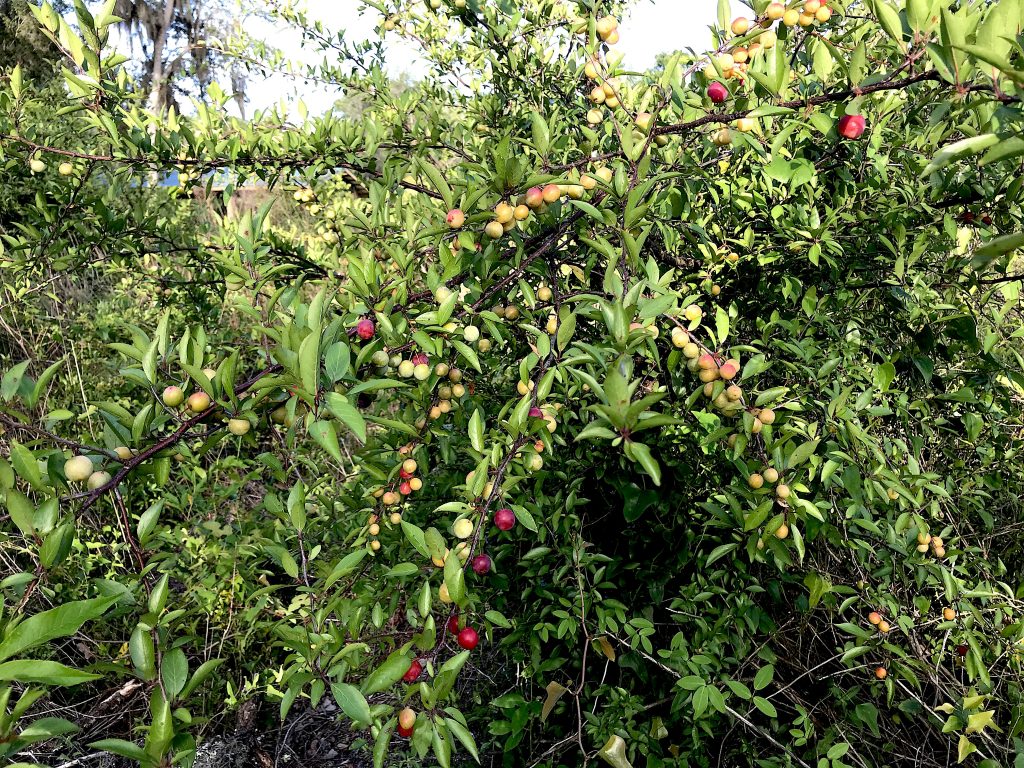
Chickasaw Plums are starting to ripen. Photo by Green Deane
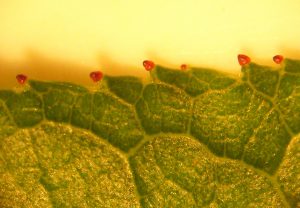
Chickasaw Plum leaf tips have red terminal glands. Photo by Green Deane
This was a “Prunus” foraging week. While rummaging around our usual class location in Gainesville we sampled Chickasaw Plums. They are just beginning to ripen and should be around for about a month. The Chickasaw Plums were not completely ripe but give them a week or two. Black Cherries are also ripening but are often more difficult to find because the birds also like them. Cherries and plums are in the same genus, Prunus, so it’s not surprising they are ripening at about the same time. Also setting fruit are the Flatwood Plums but they are different story and are included in my related article. I have a video on the Chickasaw plum here, Black Cherry here. To read about the Black Cherry go here, the Chickasaw Plum, here. Incidentally, renovations at Boulware Springs appears to be stalled and they are also removing the portable toilets. Looks like I will be needing another location for classes in the area.
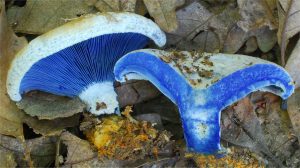
The Indigo Milk Cap is edible and easy to identify. You’ll find them for several months.
It’s been a strange week for edible wild mushrooms. Ringless Honey Mushrooms favor the fall but the right weather conditions in the spring — May specificially — can cause a minor occurrence of them. This this week there were sporadic reports of said about the South. I have even seem them on a Banyan in West Palm Beach in July. Also seen this week were a few mushrooms in the Milk Cap group. They all used to be Lactarius. Some still are but others were renamed Lactifluus (as if mushrooms weren’t confusing enough.) I saw a couple of hots Milk Caps this week — hot as in peppery — and also the one shown left, Lactarius indigo. It is indeed a pretty mushroom and edible though its texture can be a tad grainy. With rains between now and the end of the month the summer mushroom season should get a good start. Hopefully by mid-June the Orlando Mushroom Group (OMG!) can have a forage.
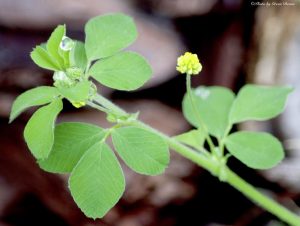
Note the long stem on the middle leaf.
You’re probably seeing a lot of this or will be seeing a lot of it and wondering what the species is. This little plant with the little yellow blossom is Black Medic. It’s generally considered edible and like many weeds is from Europe. That kind of excludes it from being a significant Native American food (though some sources call it that… It’s a long story.) The headache is that from a distance of about five or six feet (where most people’s eyes are from the ground) Black Medic can look like Hop Clover. Here’s quick way to tell them apart: Hop Clover tends to have red stems, Black Medic has green stems covered with fine white hair and has a longer stem on the center leaf. After the two species go to seed they are easy to sort out: Black Medic has black seeds… hence the name. Hop Clover brown seeds. I personally don’t view Black Medic as much of an edible but you can read more about it here.

Foraging classes are held rain, shine, hot or cold. Photo by Nermina Krenata
The resumption of foraging classes is going well and in time as it is an interesting growing time of the year. I use a portable address system so all can hear and keep the distance they are comfortable with. Foraging is treasure hunting for adults and a good way to get out in the sunshine… and sometimes rain.
Saturday, May 23rd, Wickham Park: 2500 Parkway Drive, Melbourne, FL 32935-2335. Meet at the “dog park” inside the park. 9 a.m to noon.
Sunday, May 24th, George LeStrange Preserve, 4911 Ralls Road, Fort Pierce, FL, 34981. 9 a.m. to noon. THIS CLASS IS CANCELLED AND WILL BE RESCHEDULED AT A LATER DATE.
Saturday May 30th, Eagle Park Lake, 1800 Keene Road, Largo, FL 33771. 9 a.m. Meet at the pavilion near the dog park.
Sunday, May 31st, Mead Garden: 1500 S. Denning Dr., Winter Park, FL 32789. Meet at the parking lot. 9 a.m. to noon.
For more information, the pre-pay or sign up for a class go here.
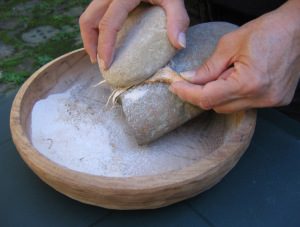
No plant produces more starch per acre than cattails.
If you were starving and came upon a patch of cattails (blossoming now) you would have great cause for celebration. You have found food and water. You will survive. But if you are not starving and do not have all the time in the inter-connected world you just might find cattails highly overrated. It is true that no plant can produce more starch per acre than cattails, about 3.5 tons under cultivation. And it can produce a lot of starch economically if you can mechanize the extraction. But hand extraction is time- consuming and labor intensive. It is also wet, smelly work all of which can be worsened significantly by harvesting in cold weather. So yes, cattails are food but the time demand is such that harvesting food has to be your prime occupation. A similar argument can be made for kudzu. The roots do have edible starch but it takes a gargantuan amount of work to get the starch out, literally hours of steady pounding. It is not a calorie positive activity. It moves you closer to starvation. But, mechanize the process with some hammers run by falling water — or hammers run by a horse fed on an endless supply of grass — and kudzo becomes a reliable calorie-positive food. You can see my video on cattails here. pounding. I also have an article on Finding Caloric Staples with links to relevant videos.

Green Deane videos are now available on a USB.
Changing foraging videos: My nine-DVD set of 135 videos has been selling for seven years. They are the same videos I have on You Tube. Some people like to have a separate copy. The DVD format, however, is becoming outdated. Those 135 videos plus 15 more are now available on a 16-gig USB drive. While the videos can be run from the DVDs the videos on the USB have to be copied to your computer to play. They are MP4 files. The150-video USB is $99 and the 135-video DVD set is now $99. The DVDs will be sold until they run out then will be exclusively replaced by the USB. This is a change I’ve been trying to make for several years. So if you have been wanting the 135-video DVD set order it now as the price is reduced and the supply limited. Or you can order the USB. My headache is getting my WordPress Order page changed to reflect these changes. We’ve been working on it for over three weeks. However, if you want to order now either the USB or the DVD set make a $99 “donation” using the link at the bottom of this page or here. That order form provides me with your address, the amount — $99 — tells me it is not a donation and in the note say if you want the DVD set or the USB.
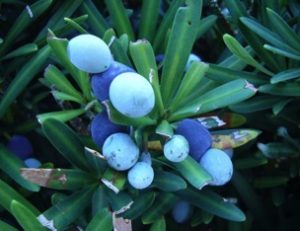
Podocarpus is setting. Photo by Green Deane
It’s a long ways to August but the Podocarpus is making seeds and that means edible arils in a few months. The species is a bit strange in that we don’t eat the mildly-toxic seed. We eat the aril next to it which are very grape-like. They can be used as grapes, eaten off the bush or made into jelly and wine et cetera. The seeds are listed as toxic but I know of an adult who ate two at one time and had no issue. That said, don’t eat the seeds. When the Podocarpus fruits can be something of a guess. Locally I look for them in August. The fruit can last several weeks and are edible even when they begin to dry and look like raisins. Oddly, in a local park in downtown Winter Park, a few Podocarpus have escaped trimming and have grown into moderate-size trees. Those fruit in December and my only guess as to why is perhaps they are a different species. My video on Podocarpus is here and you can read about it here.
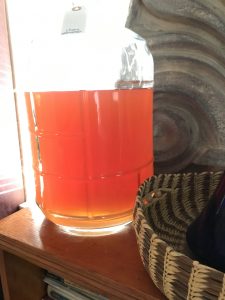
Loquat wine mellowing.
If any of you follow my Facebook page you will know I resumed making wine. I did it for literally 30 years. When I moved five years ago I stopped but the Covid-19 lockdown got me back into it. (Couldn’t go too many places and there were fruit trees ripening in the neighborhood. Ya work with what ya got.) I actually kept most of the equipment and have made up for lost time with eight musts going. Only two surprises so far. I misread a float that you use to record at the beginning and end of a fermentation to know how much alcohol and sugar you have. It indicated a reading that defied the laws of physics of this universe until I realized with older eyes I was missing a decimal point… or is it dismal point?… dim-sal point? And a batch of orange wine was lollygagging so I gave it a stir then it geysered onto the floor. Perhaps why I stopped wine making is coming back to me now… I am working on some grape wine. I’m not as bad as Tom Good on the British show Good Neighbors. He was (in)famous for his “pea pod wine.” I never made a video on crafting wine but I did one on making real vinegar from scratch. I also have one on making a quick one-week hard cider.
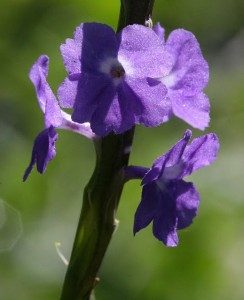
Blue Porterweed blossoms taste like raw mushrooms.
Do you like mushrooms but want to avoid some of dangers that come with fungi foraging? Then there is a subtle solution: Blue Porterweed. Found in flower gardens around the world and native to Florida the Blue Porterweed earned its name as a source for tea that tasted like porter beer. Someone had the fermenting idea to add yeast and sugar to a lot of tea and get a brew that tastes similar to porter beer, hence the name. The flower garden variety usually grows up and the local native grows horizontally. The blue flowers, raw, have a subtle flavor of mushrooms. You can read more about the Blue Porterweed here. Oh, and how did porter beer get its name? The same way porter steak did. Porters — baggage handles in old central London — worked all hours and needed quick food. Shops set up to meet that need and out of them came several dishes and named items.
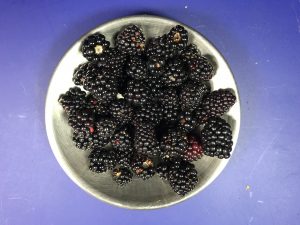
Do you know what these are? They’re fruiting now. Photo by Green Deane
Want to identify a plant? Perhaps you’re looking for a foraging reference? You might have a UFO, an Unidentified Flowering Object, you want identified. On the Green Deane Forum we — including Green Deane and others from around the world — chat about foraging all year. And it’s not just about warm-weather plants or just North American flora. Many nations share common weeds so there’s a lot to talk. There’s also more than weeds. The reference section has information for foraging around the world. There are also articles on food preservation, and forgotten skills from making bows to fermenting food.
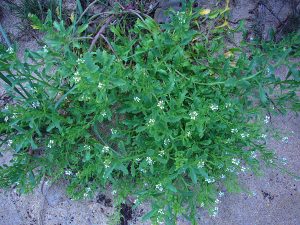
Like all mustards Sea Rocket has four-petal blossoms. Photo by Green Deane
We had a chance to visit Anna Maria Island — thanks Frank — and saw a surprise: Sea Rocket. It is not a surprise to find Sea Rocket on a beach. In fact that is about the only place you find it, and literally right in the sand. What was surprising is that we found some in May. It’s a winter species and definitely likes cooler weather. It was, however, heavily seeding so the season is closing. It has a typical mustard flavor to it and the seeds taste like Dijon Mustard. There are several species and Florida’s usually has two: Cakile lanceolata and C. edentula though there might be some subspecies. C. lanceolata tends to have pointed seed pods, C. edentula blunted seed pods. References say you can find them in the spring and summer but I have found them only in late fall to spring. C. edentula tends to be the dominant on the east coast and C. lanceolata the west coast. My article on them here.
This is weekly newsletter 406, If you want to subscribe to this free newsletter you can find the sign-up form in the menu at the top of the page.
To donate to the Green Deane Newsletter click here.
What’s blooming now? Wild Pineapple. We saw this attractive specimen in Gainesville.
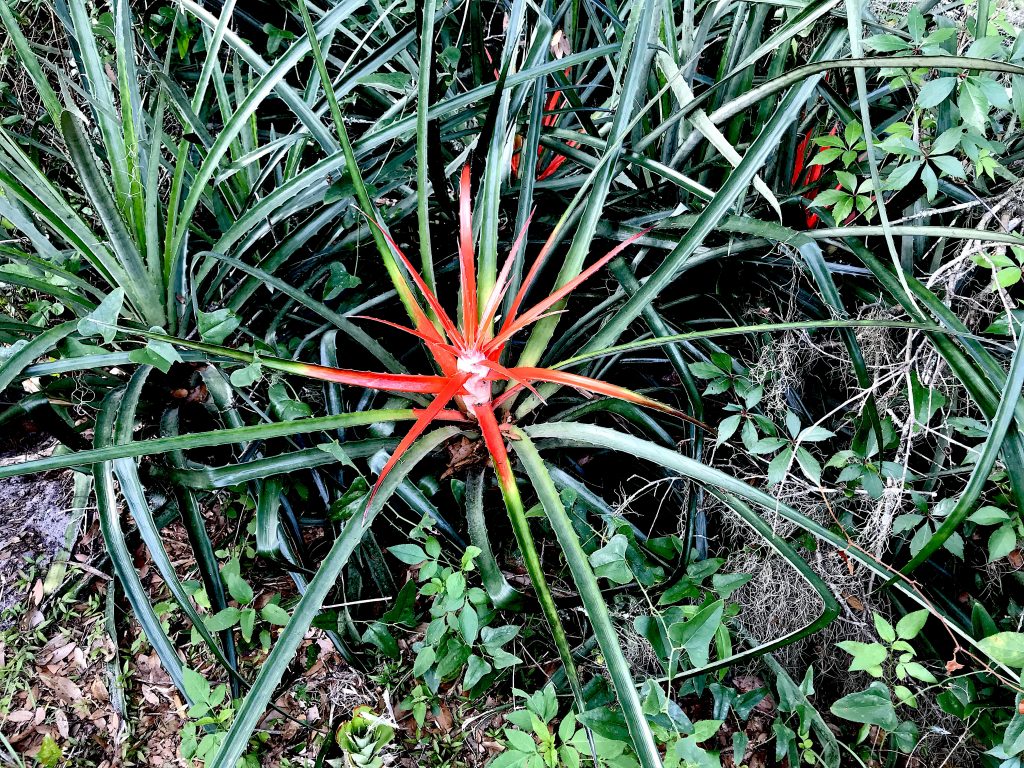


Your explosive wine reminded me of my banana wine 40 years ago. I had stashed it on the shelves of my big farm kitchen and left for the day. When I got home, many had exploded and I had sticky walls everywhere. Since then, I’ve refined my methods and things work out much better.